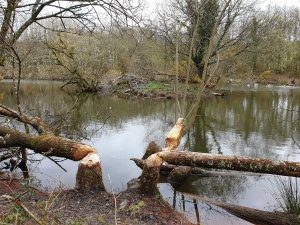[av_textblock size=” font_color=” color=” av-medium-font-size=” av-small-font-size=” av-mini-font-size=” av_uid=’av-k1vwe2ar’ custom_class=” admin_preview_bg=”]

The Beaver Code
Alice Litchfield
There can be something very tranquil about spending time immersed in nature. Through the last year a lot of us have valued our green and blue spaces more than ever before and we have spent time exploring our local areas. These outings, come rain or shine, have often been the highlight of our days and a chance to escape the routine of work and other pressures. The green and blue spaces here in the UK are home to some incredibly unique and wonderful wildlife, from the humble kingfisher to the busy beaver, and astounding ancient oak trees.

But, with summer holidays fast approaching across the UK and much of us staying in our local areas, it’s a timely reminder to respect nature, habitats and animals during our adventures.
With beavers being found across many parts of the UK, it’s useful to know how to interact and, crucially, react when in their habitat – to keep both them and us happy. Beavers are not in all river systems, but they do span the length of the United Kingdom, and so it is always a good idea to have one eye out for the signs of beavers.

Beavers are intelligent animals and leave lots of little clues for us to know they are there. If we look at the trees, there may be teeth grooves across them, particularly on oak, willow, yew and aspen trees. There may also be dams in the water with rich habitats developing in these pools. Piles of sticks, slipways into the river from the bank, and classic ‘pencil-shaped’ coppice (often with new shoots of growth bursting through depending on the age) with wood chips surround ing the feeding site – are all common clues.

If any of these signs have been spotted, please remember to keep dogs on leadsand under control. Beavers are not too concerned about humans, in fact they can be very tolerant of us! But like any animal they can become stressed or agitated if we are too close. We must give them space and actively avoid stressing them out with loud noises or off-the-lead dogs encroaching into their territory. This is especially true in the summer months when beavers, and other animals, may be rearing their young. It is best to keep our distance and respect their space.

As always, a key part of being able to enjoy nature and wildlife is keeping your distance. We should be pretty good at that after the events of the last year! It’s easy to forget how many animals are spooked by humans. Birds, beavers and bumblebees, among many others, can all find the presence of humans a little overwhelming. It is best to grab a pair of binoculars and retreat to a safe distance, also feel free to let other walkers know if you have spotted some exciting wildlife and where they need to look to get a fabulous view and keep a good distance.
Whilst rambling through the countryside can be good for our mind, it might not be so good for the undergrowth beneath our feet. If there are designated paths, try and stay on them. Beaver habitats create fantastic wetlands that support a huge range of biodiversity that will use the plants and reed-beds around the water’s edge. It is best to keep to the path to ensure no other wildlife is disturbed and other animals like water voles or maybe even otters are left in peace with no midday ramblers stomping through their patch.

And finally, always be a beaver believer. We are so happy you love nature and beavers as much as we do, and we want you to get outside and enjoy our incredible wildlife. Make sure any rubbish is stored away and take home but feel free to take as many pictures as your camera can hold.
Please forward any beaver sightings or images to us, and someone from the team will get back in touch: info@beavertrust.org or tag us on social media: @beavertrust with any of your findings. Happy walking!

Alice Litchfield
Alice has worked with many different conservation NGOs both in the UK & abroad. Now studying for an MSc in Science Communication, she is helping bring you all the beaver content on social media as our Social Media Volunteer!
#beavers #beaverbelievers #beavolution
© Alice Litchfield 2021.
[/av_textblock]




